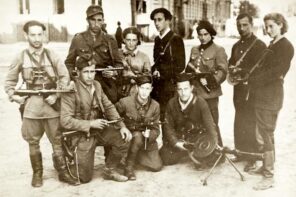When I began studying Yiddish more than a dozen years ago, the other students in class had no problem choosing appropriate names to use during our conversation sessions. David became Dovid; Rebecca became Rivka; Isaac became Itsik. There is no obvious Yiddish equivalent of Peter, so I became Pesach. Once a common Jewish name, it is also the Hebrew word for the holiday that starts later this week.
I never admitted why I felt drawn to the name. Not only am I not a Jew, I’m the son of former Christian clergy. I grew up in a post-Vatican II, liberal Catholic milieu that liked to believe the Church had shrugged off enough of its long history of anti-Semitism to begin talking about Jesus as a rabbi. In my house, we had no problem thinking about the Last Supper as a Seder. To be a Catholic named for Passover made perfect sense to me, especially during a week like this one, when the Jewish and Christian feasts coincide.
Yet the more I learned the Yiddish view of Jewish-Christian history, the more I came to realize that the easy pluralism of related rituals might be naïve. It may even obscure more meaningful connections.
A Dangerous Season
Far from an opportunity to meditate upon the Jewishness of Jesus, the overlap of Holy Week and Passover has historically been for Jews the most dangerous time of the year, when Christians fresh from their Passion Plays menaced the people they called “Christ killers.” According to the ancient blood libel, Jews were not only the murderers of the messiah; at Passover they turned knives on Christian children, bleeding them to make matzah and wine.
In Yiddish, Jews reacted to the stories wafting out of Holy Week churches with a mixture of fear and derision. The Christian savior was regularly referred to by playful nicknames like Yoizel, Getzel, and most creatively Yoshke Pandre. The layers of meaning in this last name are astonishing: Using the diminutive suffix “–ke,” Yoshke translates as “Little Joe,” tweaking Jesus’ non-biological relationship to the credulous husband of Mary. Pandre, meanwhile, is Yiddish for “panther,” a reference to the allegations dating to the second century that the father of Jesus was neither God, nor Joseph the carpenter, but a plundering Roman soldier called Pantera (Latin for “panther”). This nickname was further elaborated by taking the first part of Pandre as the honorific Pan (“Sir”), then adding a letter to the second syllable to form drek (“excrement”), applying to Jesus Christ a name roughly equivalent to a vulgarized version of Joe the Plumber: Yoshke Pan Drek.
When I first learned this history of interfaith name calling, I was working as a collector of Yiddish books, and had frequent contact with the last generation for whom the most uniquely Jewish of languages was a mother tongue. A Catholic moving through a Yiddish-speaking world, I was relieved to discover how much less theological differences seemed to matter than they once did. Visiting elderly Jews in Brooklyn, Co-op City, or the New Jersey suburbs, I was usually invited to stay a while, maybe long enough to meet a visiting granddaughter. Yes, I knew a little Yiddish, but there seemed a shared language no matter what words we used. It was a language not of theology but culture; not ritual but experience.
In my time as a Jewish book collector, I came in contact with Jewish images of my French Canadian grandparents who settled uneasily in a new country, desperate to spare their children the stigma of their foreign tongue. I also met Jewish versions of my Irish immigrant grandmother who came to this country at age 21 and died with a brogue thick as stew 75 years later. In both the Catholic environment I came from and the Jewish one in which I worked, I saw the creators of distinctly urban American cultures, men and women with the Old World still in their bones, facing the challenges of keeping ancient traditions alive.
“If You Live in Butte, Montana…”
Despite the well-meaning efforts of Christians in search of their Jewish roots, the fact that Jesus was a Jew, and that the Last Supper was a Seder, has little to do with what American Catholics and American Jews truly have in common, which is far more than our fraught religious histories would suggest. Is it possible that the saga of immigration and assimilation shared by Jews and Catholics in the twentieth century is more meaningful to contemporary religious identities than the millenia of conflicting traditions that came before?
As that great sociologist of religion Lenny Bruce once said, “Even if you are Catholic, if you live in New York you’re Jewish. If you live in Butte, Montana, you are going to be goyish even if you are Jewish.”
During a week of religious collision that once meant trouble, it is hopeful that the names Catholics and Jews once called each other may soon be as forgotten as Yoshke Pan Drek. In the meantime, even a goy a called Pesach can be pleased to live at time when holy days intersect without bloodshed, in a place where rituals inform but do not define us.




